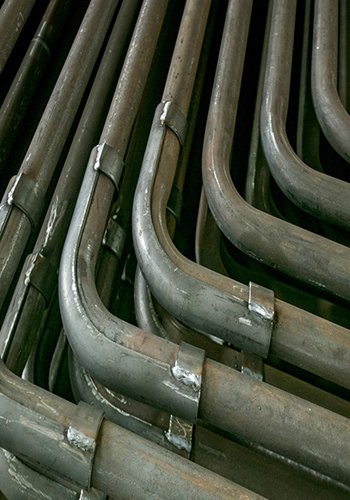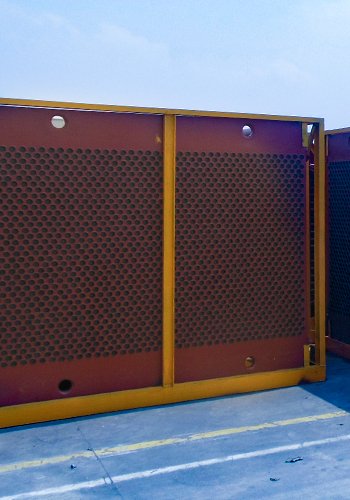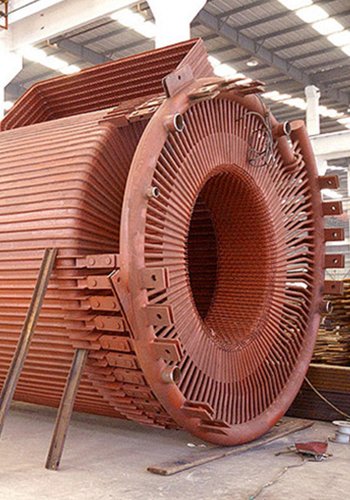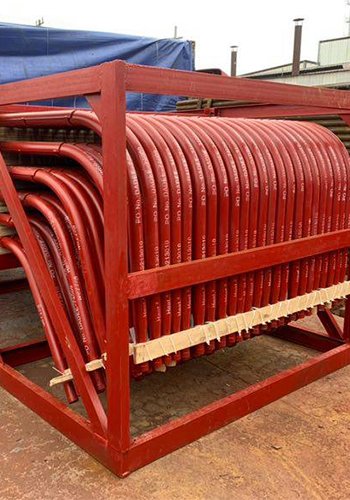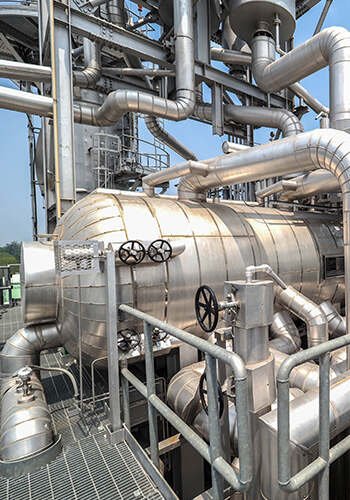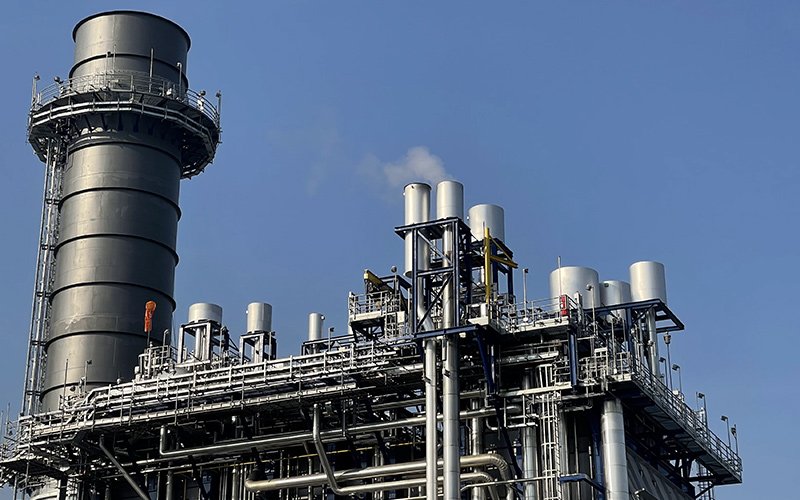Water is the primary working medium in waste heat power generation boilers. During the operation of these boilers, due to evaporation and concentration, the concentration of boiler feedwater increases, leading to the formation of scale and water slag. Therefore, ensuring that boiler feedwater and boiler water meet water quality standards is essential for the safe and energy-efficient operation of waste heat power generation boilers.
In industrial waste heat power generation boilers, feedwater is typically subjected to simple ion exchange softening treatment. However, even in softened water, there are certain metal cations such as Ca2+, Mg2+, Fe2+, Mn2+, and anions such as Cl–, SO42-, SiO32-, HCO3–. These impurity ions undergo various chemical reactions during the heating process of boiler water, leading to thermal decomposition, thermal concentration, and, in severe cases, causing scaling (a 1 mm scale layer can increase fuel consumption by 7%), corrosion, and changes in steam quality. These issues pose threats to the operational safety of the boiler and reduce equipment lifespan. Reducing boiler water concentration through blowdown is a crucial measure for the safe and economically efficient operation of industrial waste heat power generation boilers. This helps reduce energy and water treatment waste caused by excessive blowdown. Controlling the concentration of impurities in boiler water based on the composition of feedwater impurities is the goal of boiler blowdown, minimizing the harm caused by high-concentration furnace water to boiler operation and, simultaneously, conserving water resources and energy.
The discharge from boiler blowdown contains not only high levels of dissolved solids but also a significant amount of thermal energy. Thus, boiler blowdown has a dual nature – on one hand, not blowing down can lead to scaling, corrosion, and impact on boiler safety; on the other hand, blowdown results in heat loss and water resource wastage. The solution to this contradiction involves two approaches: firstly, utilizing new water treatment technologies to reduce the salinity of boiler feedwater, thereby reducing the entry of impurity ions into the boiler and lowering the boiler blowdown rate; secondly, employing blowdown technology to achieve scientifically accurate blowdown while simultaneously recovering the thermal energy from blowdown water.
Operating Efficiency of Waste Heat Power Generation Boilers
Several factors impact the operating efficiency of waste heat power generation boilers. For steam boilers, a critical consideration is the presence of a certain amount of dissolved solids in boiler feedwater. To ensure water and steam quality during operation, a significant amount of blowdown is necessary. However, in the case of waste heat power generation boilers, the discharged blowdown is high-temperature and high-pressure water containing a substantial amount of absorbed heat. Maximizing boiler heat utilization and minimizing boiler blowdown while maintaining water and steam quality can enhance the thermal efficiency of waste heat power generation boilers and reduce costs.
In general, with the adoption of appropriate water treatment processes and proper blowdown control methods, the blowdown rate for industrial steam boilers should not exceed 10%. However, in many steam boilers in China, improper control of blowdown has led to blowdown rates as high as 20% to 30%. Additionally, the heat from the blowdown is often not effectively recovered or has a low recovery rate, negatively impacting the operational efficiency of the boiler.
Waste Discharge Control Methods for Waste Heat Power Generation Boilers
2.1 Water Quality Control and Blowdown in Waste Heat Power Generation Boilers
Upon entering the waste heat power generation boiler, feedwater undergoes evaporation, leading to an increase in salt content in the boiler water. When the concentration reaches a certain level, foam is generated, resulting in the simultaneous release of steam and water vapor. This significantly increases steam humidity and, in severe cases, can cause the waste heat power generation boiler to shut down due to low water level. This phenomenon is particularly evident during high boiler and steam load fluctuations. Therefore, it is crucial to maintain the salt content in the boiler water within allowable limits to ensure the safe and stable operation of the boiler.
The primary method for controlling water quality and reducing salt content in the boiler water is through blowdown during boiler operation. This involves continuously discharging high-concentration boiler water near the evaporative surface inside the boiler, as well as accumulated water slag, while simultaneously replenishing the waste heat power generation boiler with feedwater of relatively lower salt concentration. Clearly, blowdown helps reduce the salt content in the boiler water, thereby improving water quality. The amount of blowdown required to meet national standards must be determined through chemical analysis and calculations. If the actual blowdown exceeds the calculated amount, water quality improves, but at the same time, a significant amount of high-temperature water with thermal energy is discharged, increasing the thermal loss from blowdown in the waste heat power generation boiler. Only when the actual blowdown is equal to (or close to) the calculated blowdown, can the concentration of boiler water remain stable near the values specified in the national industrial boiler water quality standards. This ensures both water quality and prevents unnecessary energy waste caused by excessive blowdown.
2.2 Retrofitting of Blowdown System in Waste Heat Power Generation Boiler: Previous Production Situation
2.2.1 Overview of the Process Flow
Prior to the retrofit, the blowdown system for the boiler was manually controlled, with manual valves for AQC and SP boiler blowdown, as shown in Figure 1.

Figure 1: Blowdown System of Waste Heat Power Generation Boiler Before Retrofit
2.2.2 Issues with the Boiler Blowdown System Before Retrofitting
(1) Design Blowdown Rate Deficiency:
The designed blowdown rate for boiler water was less than 10%, and the actual blowdown flow exceeded 181 kg/10 s, as indicated in Table 1.
| Blowdown Flow (/kg/10 s) | Blowdown Rate (%) | Phosphate Ion (/mg/L) | Alkalinity (/mmol/L) | pH |
|---|---|---|---|---|
| 247 | 18 | 24 | 23 | 11 |
(2) Periodic Blowdown:
The operational time was prolonged, with periodic blowdown occurring once per shift. Operators needed to open 30 blowdown valves manually, each time for 30 seconds, followed by manual closure, resulting in a total process time of 20 minutes.
(3) Frequent Manual Valve Operation:
Frequent manual valve operations increased the risk of damage, added to the maintenance workload, and heightened management complexity.
(4) Inconsistent Blowdown Rate Adjustment:
Manual adjustment of the blowdown rate to ensure thorough blowdown led to an excessive blowdown rate, resulting in wasteful energy consumption in the waste heat power generation boiler.
Boiler Blowdown System Retrofit Process
3.1 Retrofit Solution for Boiler Blowdown Automation
Building upon the existing infrastructure, the retrofit involved modifying the blowdown pipeline, installing valve supports, and replacing the manual secondary blowdown valve with an electric valve controlled by a PLC on a scheduled basis. The PLC automatically controls the blowdown, and manual adjustments can be made based on the factory’s requirements. This retrofit aimed to enhance the reliability and stability of the boiler drum periodic blowdown process.
This comprehensive solution includes a blowdown signal that triggers a remote alert through the central control Distributed Control System (DCS). Operators can then remotely control the valve opening through the central control or manually operate it on-site through the distribution cabinet, as illustrated in Figure 2.

Figure 2: On-site View of Boiler Blowdown System after Retrofit
After a period of operation, the retrofitted boiler blowdown system demonstrated stable automatic operation, normal parameters, and, according to laboratory results, the final blowdown rate was less than 20%, with a blowdown flow of less than 181 kg/10 s, meeting boiler water quality standards. The water quality test data are presented in Table 2.
| Blowdown Flow (/kg/10 s) | Blowdown Rate (%) | Phosphate Ion (/mg/L) | Alkalinity (/mmol/L) | pH |
|---|---|---|---|---|
| 100 | 8 | 16 | 13 | 11 |
From the operating parameters, it is evident that various water quality parameters have improved to a certain extent, and the stability of the operation has significantly increased.
3.2 Comparison between Automatic and Manual Control of Boiler Blowdown in Waste Heat Power Generation Boilers
Currently, most industrial boilers in China employ manual valve control for blowdown, typically installing a manual shut-off valve at the blowdown outlet. Boiler water samples are collected regularly by water analysis personnel, and the concentration of chloride ions and alkalinity is determined using chemical titration methods. Based on the test results, the personnel inform the waste heat power generation boiler operators to open or close the blowdown valve. This manual control is usually conducted once or twice per shift (8 hours). In practice, manual control methods often fail to meet the requirements for controlling water quality. To ensure that the boiler water concentration does not exceed the standard between two rounds of water sampling and analysis, each time the blowdown valve is opened, the control indicators of the boiler water are discharged to a very low level. However, even this approach cannot guarantee the water quality compliance during this period. This is because, under high steam load conditions, the concentration of boiler water rises rapidly, and manual control cannot detect changes in the actual dissolved solids in the boiler water. Therefore, it cannot open or close the blowdown valve in a timely manner, leading to poor control of boiler indicators and resulting in energy waste.
On the other hand, boilers equipped with automatic control systems automatically open the blowdown control valve based on the set system parameters and stop the blowdown automatically after a designated time. This reduces the blowdown volume and saves on the operational costs of the waste heat power generation boiler.
3.3 Operational Status after Retrofitting the Automatic Blowdown System in Waste Heat Power Generation Boiler
Since the completion of the retrofit on September 7, 2021, the results have been significant, addressing not only the stability and water quality issues but also yielding certain economic benefits.
(1) Stable and Reliable Operation:
After long-term on-site testing, the program-controlled start, stop, and various functions have been consistently normal.
(2) Simple Structure:
The retrofit does not require a specialized control device; connecting the I/O lines of the electric valve to the PLC is sufficient. Since the operation control is achieved through software, there are no hardware-related issues with the control device.
(3) Convenient Operation:
The DCS operating screen is designed with pop-up windows, allowing direct soft operation within these windows. The pop-up windows display the operation status of each valve and provide real-time information for operators, as shown in Figure 3.

Figure 3: Boiler Blowdown System Interface
(4) Flexible Operation:
On the operating screen, malfunctioning electric valves (not participating in the program control) can be bypassed, allowing normal electric valves to participate in program control. This enhances operational flexibility.
(5) Comprehensive Functionality:
The interface enables manual and automatic operations, displaying and alarming functionalities to help operators monitor operations and promptly address issues.
(6) Convenient Parameter Modification:
Parameters, such as blowdown times for electric valves, can be easily modified in the configuration based on the actual needs of the site.
Conclusion
Based on the principles and theories of water treatment for waste heat power generation boilers, our company successfully carried out the automation retrofit of the blowdown system, achieving favorable results.
The implementation of automatic blowdown control has brought several beneficial effects, including excellent sealing performance, effective blowdown results, long service life, easy installation, and time-saving advantages. This automation has reduced manual blowdown waste, saved softened water, and ensured water quality, contributing to the prevention of scaling and corrosion in the boiler. The automated system can withstand high-load operations, is easy to install, operates reliably, and is convenient for maintenance and management. Additionally, it offers remote control functionalities such as start/stop, alarms, manual, and automatic control.
In summary, the automated retrofit of the blowdown system aligns with the water treatment principles for waste heat power generation boilers, resulting in improved efficiency and operational benefits.
[1] Cai Zuming. Industrial boiler water quality requirements and treatment methods [J]. Science and technology rich guide, 2011(20):277-278.
[2] Mou Shuqin. Boiler water treatment operations [M]. Beijing: China Labor and Social Security Press, 2012.
[3] Chen Lifen. Analysis and application of energy saving measures for industrial boilers [J]. Huazhang, 2011(14):319.
[4] Guan Wenji. Analysis of waste heat recovery from continuous discharge of steam boiler[J]. HVAC, 2010(1):51-54+70.
DHB Boiler
Discover The Superior Quality And Cutting-Edge Technology Of DHB Boilers. Explore Our Range Of Biomass Boilers, Waste Heat Boilers, And More. Take Your Industrial Operations To New Heights With DHB Boiler.
